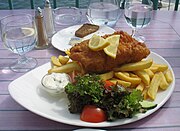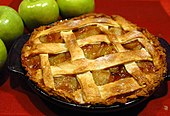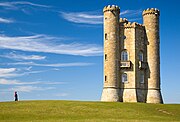
Since the Early Modern Period the food of England has historically been characterised by its simplicity of approach such as meat and two veg, honesty of flavour, and a reliance on the high quality of natural produce. During the Middle Ages and through the Renaissance period, English cuisine enjoyed an excellent reputation, though a decline began during the Industrial Revolution with the move away from the land and increasing urbanisation of the populace. The French sometimes referred to English people as les rosbifs, as a stereotype to suggest English food is crude or unsophisticated. However, the cuisine of England has recently had a more positive revival with the critics, with some good ratings in Restaurant's best restaurant in the world charts.[161] An early book of English recipes is the Forme of Cury from the royal court of Richard II.[162]

Traditional examples of English food include the Sunday roast; featuring a roasted joint, usually beef, lamb or chicken, served with assorted boiled vegetables, Yorkshire pudding and gravy.[163] Other prominent meals include fish and chips and the full English breakfast—consisting of bacon, grilled tomatoes, fried bread, black pudding, baked beans, fried mushrooms, sausages and eggs. Various meat pies are consumed such as steak and kidney pie, shepherd's pie, cottage pie, Cornish pasty and pork pie, the later of which is consumed cold.[163] Sausages are commonly eaten, either as bangers and mash or toad in the hole. Lancashire hotpot is a well known stew. Some of the most popular cheeses are Cheddar and Wensleydale. Many Anglo-Indian hybrid dishes, curries, have been created such as chicken tikka masala and balti. Sweet English dishes include apple pie, mince pies, spotted dick, scones, Eccles cakes, custard and sticky toffee pudding. Common drinks include tea, which became far more widely drunk due to Catherine of Braganza, while alcoholic drinks include wines and English beers, usually drank in public houses such as bitter, mild, stout and brown ale.[165]






